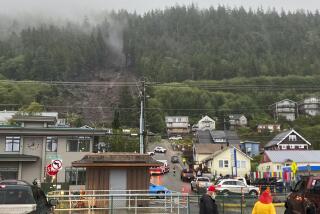Anguish and uncertainty in search for Washington mudslide victims
- Share via
ARLINGTON, Wash. — Danger and uncertainty hang like a pall over the small towns along the Stillaguamish River.
The mudslide that tore across State Route 530 — leaving nearly a square mile of debris and slicing a scar in the hillside taller than the Washington Monument — threatened to continue moving Monday.
Search-and-rescue teams equipped with sonar, hovercraft and dogs were pulled back from the hardest-hit area for two hours out of fear that they too might become casualties of Saturday’s deadly slide.
But once the site was deemed safe enough, rescuers returned and found six more bodies, a discovery that brought the confirmed death toll to 14.
The number of men, women and children still missing or unaccounted for, however, was even more shocking to this rural region an hour north of Seattle.
That figure — specific yet painfully approximate — rose throughout the day, from 18 to 108 and finally to 176. Officials struggled to explain their disclosure Monday while sharing the grief that has gripped their communities.
“We have 108 individual names or individual identities” on the missing list, John Pennington, director of the Snohomish County Department of Emergency Management, said early Monday. But “it’s a soft 108 ... that’s going to decline dramatically.”
Ten hours later, he shifted gears, saying, “The approximate number of names is 176, and it’s exactly what we’re looking for, information and data.”
Officials had implored friends and family members Monday morning to call and report their missing loved ones, and they obliged. Pennington said the list probably contained duplicates that must be sorted out, dueling descriptions like “John Doe, 123 Steelhead Lane, brown hair, brown eyes” and “John, 76.”
“The 176, I believe very strongly, is not going to be a number of fatalities,” he said as dusk fell. “We’ve got 176 names. We’re trying to whittle that down.”
The tiny enclave of Oso, where the slide hit, is home to about 200 people. But the list of missing was so high, Pennington said, because “it was Saturday, there were workers, there was uncertainty and there was transportation on Highway 530.”
Reed Miller, whose son Joseph is on that list, wasn’t surprised.
“I figured there were still a lot of people in their homes or outside,” he said, as he huddled with his family near the Red Cross shelter. “They wouldn’t have a chance with the speed of that mountain.”
The mobile home where father and son lived was destroyed in the mudslide. Miller said he planned to camp out at the Arlington shelter until he heard news about his son. Even bad news, he said, would be better than not knowing.
“The night before last, I lay in bed having visions of my son being alive, but dying of hypothermia,” he said. “I’m guessing he’s probably buried under — how much mud I don’t know. My house was closest to the slide.”
Miller calls his son’s cellphone over and over. There is no answer.
But Jerry VanBibber says uncertainty is his friend.
The Arlington chef staked out the sidewalk outside Safeway to solicit donations of money and food for survivors of the disaster. His wife works at the local Wal-Mart, where five or six of her colleagues have family members on the missing list.
“We have some very close friends who I hope are still kicking, but I don’t know,” VanBibber said. “If I don’t know, I can still pray for the best. I can still hope they’re at someone’s house. But if I got bad news, I’d be devastated.”
Even from a geological standpoint, the mudslide that left a square mile of slurry and wreckage near Oso was one of the most dramatic slides — and disasters — to hit Washington state in recent memory.
“This is one of the biggest landslides I’ve seen,” state geologist Dave Norman told reporters Monday.
Experts primarily blamed the slide on heavy rains that have saturated western Washington. Arlington has seen 7.33 inches of rain this month, the fourth-highest total ever recorded in March, according to the National Weather Service.
But geology and history are part of the problem, said David Montgomery, a geologist at the University of Washington.
Scars from similar mudslides can be seen across western Washington where, more than 10,000 years ago, a glacier left loosely-packed soil and silt where Snohomish County now sits.
Landslides “don’t tend to happen all that often in human time,” Montgomery said. “But if you look in geologic time, they’re not that uncommon up here.”
Saturday’s slide destroyed 49 homes, half of which are occupied full time, officials said. Searchers have been wading through mud and debris, pools of propane and the contents of septic tanks, looking in crushed houses and damaged cars for survivors — anyplace that might have a pocket of air for victims to breathe.
“One of the responders out there said that when they finally find a house that’s smashed up, it is collapsed and compressed” and filled with mud “like cement,” said Travis Hots, chief of Snohomish County Fire District 21. “It takes an hour to move four buckets of material.”
For the last two days, the search has yielded only bodies.
Pennington was asked late Monday when the search-and-rescue work would give way to a recovery effort, when instead of looking for survivors, authorities would just look for bodies.
“Most of us in these communities believe that we will not find any individuals alive,” he acknowledged. “I am a man of faith. I believe in miracles. But we are moving toward a recovery operation.”
He paused and reflected.
“Until the point we feel the need to stop,” he said, “we will keep moving.”
La Ganga reported from Arlington and Pearce from Los Angeles.
More to Read
Sign up for Essential California
The most important California stories and recommendations in your inbox every morning.
You may occasionally receive promotional content from the Los Angeles Times.











